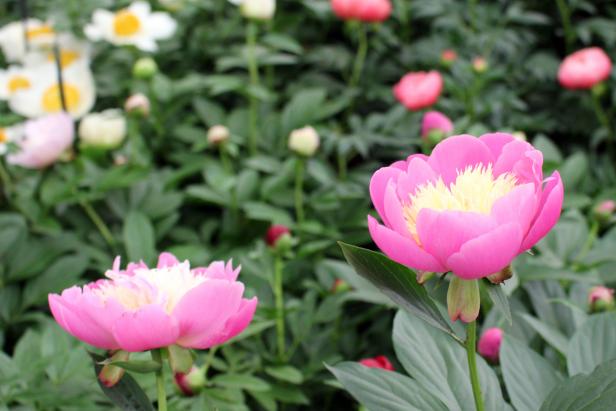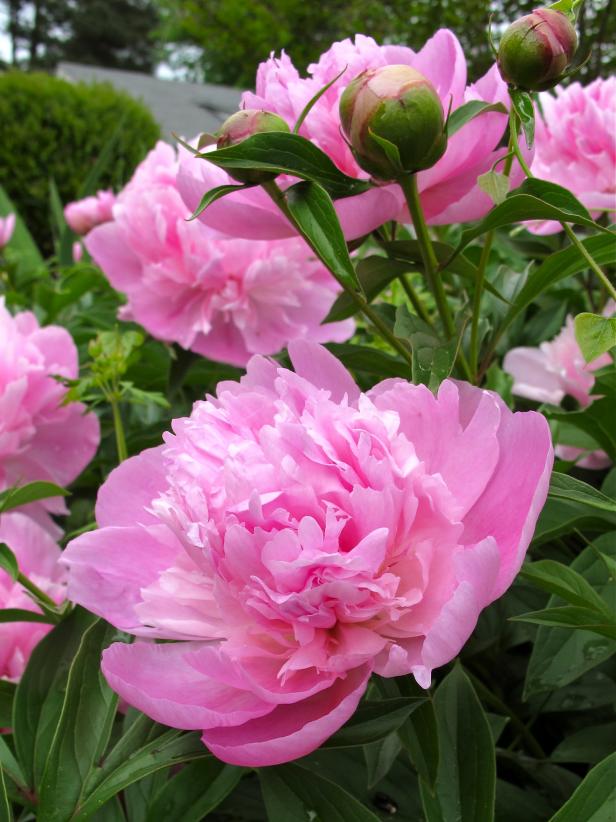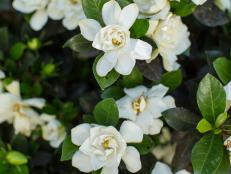Peony Flowers: How to Plant and Care for Peonies
Learn how to bring fragrant, fluffy peony flowers to your garden including tips on when to plant peonies, how to plant them and peony diseases to watch out for.

The peony 'Felix Crousse' is a hardy grower and a fragrant double variety.

Peonies are perennials, meaning they return every year, bringing outrageously beautiful blooms to your garden each spring. Peonies have been known to thrive for more than a century, so your peonies may outlive you. They love cold winters and need chilling time to make flowers.
Native to Europe and Asia, peonies have been grown in domestic gardens in Asia for 4,000 years. They gained mass popularity in the West in the 19th century, becoming a staple of Victorian gardens in Europe and the United States. Peonies have remained a garden favorite because they grow such gorgeous blooms and are so hardy.
Types of Peonies
Herbacious, Tree and Itoh Peonies
Of the more than 6,500 cultivars of peonies, there are just three general types: herbaceous, which grow on green stems; tree, which are woody stemmed shrubs; and itoh, or intersectional, which are a hybrid of tree and herbaceous. Herbaceous peonies are the most widely grown type and the most cold hardy, with some varieties able to withstand temperatures as low as 20 below zero.
39 Eye-Popping Peonies 39 Photos
These gorgeous, lush flowers bring old-fashioned glamor to the garden.
Peony flower colors range from white, pink and red to coral, maroon and yellow. Many peony flowers are fragrant, with some varieties smelling like citrus and others like spice. They come in a range of flower forms, including single, Japanese, anemone, semi-double and full double.
Botanical Name: Paeonia
Common Names: Peony
Hardiness Zones: 3 to 8 (Some varieties to Zone 4)
Bloom Time: April to June
When Do Peonies Bloom?
Peonies bloom in spring, sometime between April through June, though the precise time varies by peony type and the region in which you live. You can find varieties of herbaceous peonies listed as early, mid-season and late bloomers. Include a mix of these types to extend peony season in your garden.
You can expand peonies season even more by planting tree peonies, which open their elegant blooms before herbaceous peonies. Itoh peonies' blooming season typically overlaps the flowering window of herbaceous peonies, although Itoh peonies hold their flowers open longer than herbaceous types.
Herbaceous peonies need a certain amount of cold weather to flower. Southern gardeners should plant early-blooming varieties that need less cold to thrive.
When To Plant Peonies
- Plant bare root peonies in the fall before at least six weeks before first frost. You may get blooms in the spring when you plant in the fall.
- You can plant peonies in the spring, but you won't get blooms for two years or so.
How To Plant Peonies
Peonies are usually sold as bare root tubers or as a 3- to 4-year-old plant in a container.
- Choose a planting site with full sun (six to eight hours per day), except in southern and southwestern regions, where afternoon shade is ideal.
- Dig planting holes large enough so peony divisions and roots easily fit. Plant the eyes 2 inches below the soil surface in cold regions, 1 inch in warm zones. Any deeper and you'll get foliage but not flowers.
- Give peonies room. A plant can mature to a width of 5 feet, so space peonies accordingly. Wider spacing allows plants to form large clumps that are almost shrub-like. Closer spacing works well when you're planting a hedge of peonies or incorporating them into beds with other perennials. The trickiest part of how to plant peonies is not burying tubers too deeply.
- When planting a container-grown peony, make sure the surface of the roots are level with the ground.
- Peonies do best in rich soil that's been amended with organic material when you plant them.
- Peonies need good drainage. They hate soggy roots, so put them in a raised bed or on a slope.
- Plant them far from trees and shrubs because they don't like competition from other roots for nutrients and water. If their neighbors' roots disturb them, they'll stop blooming.
- You can grow peonies in a pot, but they are happiest in a garden. If you must have peonies in a pot, choose one with lots of drainage holes and plan on watering more frequently since containers dry out.
Caring for Peonies
- When peonies are stressed, their leaves curl. They may need water, or they may be too hot or too cold. Most plants recover and bloom when conditions are better.
- After the first frost, remove old foliage. New growth comes from the roots.
- Tall peonies may need support to keep from falling over. Using bamboo stakes, metal flower rings or tomato cages.
- Deadhead peonies as they bloom.
- Cut the foliage to the ground in the fall to avoid diseases over the winter.
- Mulch loosely and lightly where winters are severe. Remove mulch in spring.
When to Transplant Peonies
Every 10 or 15 years, you'll need to thin peonies out, so the plants don't get overcrowded and strangle one another out. Other reasons you would transplant a peony: you're moving and want to take some of the plant with you. Or you want share your peony with a gardening pal. The best time of year for dividing and transplanting peonies is early fall. Here's how you do it.
- Clip leafy stems back to near ground level, 2" to 3" tall.
- Use a sharp spade to dig beneath the peony clump. Start digging about a foot away from the stems. As you dig around and beneath plants, try to cut as few roots as possible.
- After loosening soil, lift the peony clump from the hole. Place it on a tarp. Gently shake the peony plant so soil falls away from roots.
- Using your hands, divide the peony roots into sections or divisions. Each division needs to have three to five eyes or growing points. Eyes are the places on the roots that produce stems and leaves.
- Allow root pieces to dry out and callus, or form a hard layer, before planting to lessen the chance of root rot after planting. This will take a few days.
- Replant as directed above.
- Peonies really hate being moved, so don't expect yours to bloom the year after you move it.
When to Cut Back Peonies
Keep your pruners sharp if you grow peonies. These perennial favorites require only moderate pruning, but it’s important. Knowing when to cut back peonies is vital to keep diseases at bay, as is deadheading peonies. Not sure when to cut down peonies? Do you deadhead peonies? If you have questions about peony pruning, we have answers.
Both times you prune these perennials — when you’re cutting back peonies and deadheading peonies — you’re tackling simple tasks that don’t require too much expertise. When you’re cutting peonies, like any plant, it’s a good idea to wear gloves to protect your hands. Make sure pruners are sharp and clean before starting any cutting job.
Deadheading peonies is the process of removing spent blooms. When you remove faded flowers, you stop plants from producing seed pods, which allows plants to direct all energy toward food storage in tubers. That stored food supplies the energy needed for next year’s growth and flowering. Faded peony flowers also tend to develop fungal diseases, like botrytis, as petals rot. By removing the blossoms, you can help keep fungal diseases at bay.
When deadheading peonies, some gardeners just snip off the flower head itself, but this leaves a long stem in place that stands taller than the rest. It’s better to follow the flower stem into the plant and place your cut about half an inch above the leaves.
Cutting back peonies is a once-a-year task. When to cut back peonies? The right time for peony pruning is in fall, after frost has killed leaves. How to prune peonies? Clip stems as close to the ground as possible. Gather all leaves, stems and any other plant debris. Don’t compost this leafy material; bag it and put it out with the trash. Destroying it is better because peonies often have fungal diseases that can survive winter on a piece of leaf or stem.
Peony pruning really only comes into play with tree peonies, which have woody stems. With these plants, pruning isn’t usually necessary. The most common pruning you’ll tackle with tree peonies is removing winter-damaged wood in late spring. This occurs most often in colder regions where harsh winters can kill some of the stems. Wait to prune until late spring, when growth has clearly resumed from some of the buds. Place pruning cuts just above an outward-facing bud. Cut stems at an angle.
Some gardeners argue that there’s never an occasion for pruning peonies. They don’t believe in deadheading, saying it makes no difference on plant health. Other gardeners never worry about cutting back peonies in fall and just let leaves deteriorate in the peony patch. Deciding to tackle peony pruning is really a personal choice, but it will always help improve the health of your plants. Removing hiding places for diseases is one of the best ways to keep any plant problem-free.
Peonies Diseases and Pests
- Peonies are prone to powdery mildew which, while ugly, will not kill your plants. Prevent mildew by spacing your peonies to allow good air circulation, and planting them in full sun so they dry out quickly after waterings.
- Peonies are susceptible to verticillium wilt, ringspot virus, tip blight, stem rot, leaf blotch, Japanese beetles and nematodes.
- Ants. Peony buds' sweet nectar attracts hungry ants. They won't hurt the plant and they're helping you by eating bad bugs that attack your peonies, so don't spray pesticide on them. If you're cutting the flowers to bring indoors, gently rinse the blossoms with water to get rid of the ants.
- Peonies are deer-resistant.
Recommended Peony Flowers
'Bowl of Beauty' blooms in mid-spring with 10-inch wide pink and creamy white flowers that have a cupped shape.

'Bowl of Beauty' stays true to its name with a bowl-like shape made of large, vibrant pink petals with pale yellow petals in the center.
'Border Charm' is a cross between an herbaceous and tree peony. It has yellow flowers and growns on relatively short 22-inch tall stems.
'Karl Rosenfield' was introduced in 1908 and is one of the all-time favorite red peonies. It has double blooms on a 32-inch tall plant.
'Festiva Maxima' is an heirloom from the 1850s that's still popular. It bears frilly white flowers with crimson flecks that have an intoxicating rose-like scent on a 3-foot shrub.
'Sarah Bernhardt' is a famed heirloom from 1909 named for the famed actress of that era. It has soft, double pink flowers and a sweet fragrance.

Image provided by Felder Rushing
'Sarah Bernhardt' is one of several very early-blooming peonies
Garden Design Suggestions
- Plant peonies with Shasta daisies, iris, baby's breath or flax.
- Plant them in mixed borders for color and texture.
- Use peonies as a low, informal hedge.
- Plant tree peonies along a walkway or porch.
- Peonies make excellent cut flowers. They're popular in bridal bouquets or as an informal arrangement in a jar on your kitchen island.
Great Choices to Pair With Peonies
Take your peonies to the next level by pairing them with plants that really make them sparkle.















































